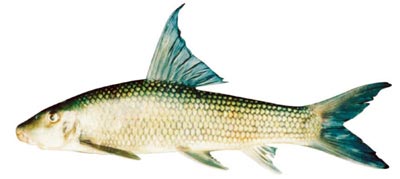Four fish species: the striped catfish, the giant river catfish, the carp, and the Asian arowana in the Red River system are at risk of extinction. The catch of these four species has decreased to only 10-15% of the yields from the 1970s and 1980s; in fact, the yield of the giant river catfish is now approximately just 1%.
 |
|
Asian Arowana – one of the four rare fish species in the Red River. Photo: fishternet |
This information was recently published in the Research Survey Report on the status and measures for the protection and restoration of certain rare and endangered fish species in the Red River system by authors Pham Bau, Nguyen Duc Tuan, Bui Dinh Dang, and Nguyen Cong Thang (Aquaculture Research Institute I).
According to the report, the four rare fish species are scientifically named: striped catfish (Hemibagrus guttatus Lacépède, 1803), giant river catfish (Bagarius yarrelli Sykes, 1839), carp (Spinibarbus denticulatus Oshima, 1926), and Asian arowana (Semilabeo obscurus Lin., 1981). However, the yields of these fish, considered top specialties of the Red River system, are at risk of extinction, classified as critically endangered level 2.
The report indicates that the distribution of these four fish species in the Red River system is increasingly shrinking, generally trending upstream to more rugged terrains, with very few or no sightings downstream. Their spawning grounds are virtually non-existent, and fish spawn are scattered throughout the upstream areas of the rivers and streams.
The authors note that the population of these four rare fish species has diminished. If we do not implement timely, synchronous, and robust protective measures, the risk of their extinction will become a reality.
Therefore, the research team recommends that the Ministry of Fisheries and relevant authorities strictly enforce the Fisheries Resources Protection Ordinance, such as banning fishermen from automatically catching and consuming rare fish; prohibiting the use of destructive methods like electric shock, explosives, and toxic substances; guiding the use of small mesh nets and hooks to avoid harming juvenile fish; managing sand extraction and gold panning activities in riverbeds… as these activities significantly affect the habitats of fish species; monitoring and controlling the discharge of waste from industrial plants.
Additionally, the report proposes the establishment of nature reserves along the Red River. The construction of stations and facilities in key areas should be undertaken. Research on biological aspects and breeding should be initiated. Moreover, cooperation between the fisheries and irrigation sectors is essential in constructing hydroelectric dams.
In the long term, further investigations into the biological characteristics, techniques for artificial breeding, and rearing of these rare fish species should continue.
Currently, scientists at the Aquaculture Research Institute I have conducted experimental farming of three fish species: striped catfish, giant river catfish, and carp in cages and ponds, yielding promising results. The striped catfish shows good potential when raised in ponds with irregular water supply, but results in cages are still limited. The giant river catfish thrives in cages but is unsuitable for static water ponds requiring periodic water changes. The carp is suitable for farming in ponds and cages under conditions in the northern mountainous regions.
Ha Yen

















































